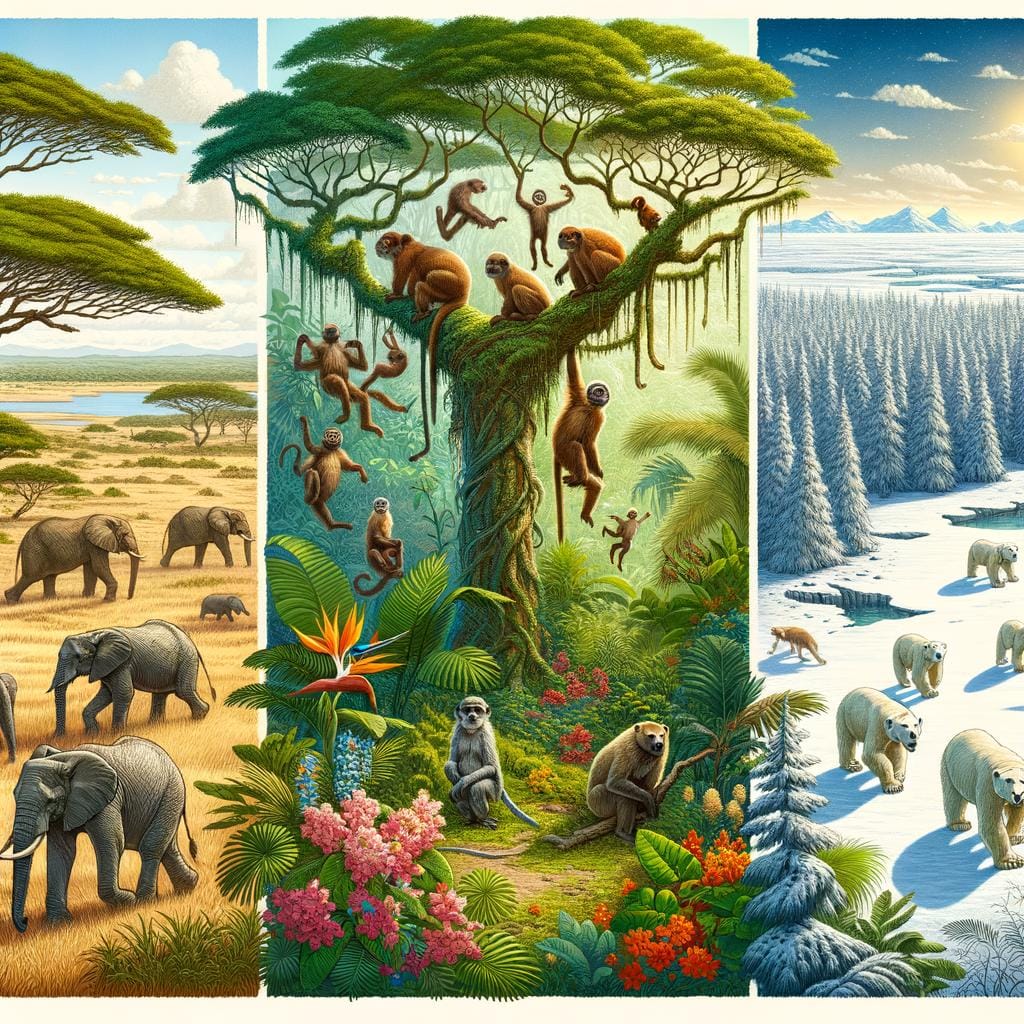Animal habitats play a crucial role in maintaining the delicate balance of our ecosystem. These diverse environments, ranging from forests to oceans, provide essential resources and shelter for a wide variety of species. Understanding the significance of animal habitats is key to preserving biodiversity and ensuring the well-being of our planet.
Different types of habitats, such as deserts, grasslands, and oceans, have unique characteristics that make them suitable for specific animals to thrive. Each habitat offers a range of resources like food, water, and shelter that are essential for the survival of its inhabitants. Animals have evolved over time through physical and behavioral adaptations to effectively navigate and thrive in their respective habitats.
Unfortunately, human activities like deforestation, pollution, and climate change pose significant threats to animal habitats worldwide. The destruction of these natural spaces not only endangers countless species but also disrupts the entire ecosystem. Conservation efforts, including the establishment of national parks and wildlife reserves, are crucial in protecting and preserving animal habitats for future generations.
Types of Animal Habitats
Forests, deserts, oceans, and grasslands are some of the most diverse and fascinating types of animal habitats found around the world. Each of these habitats offers a unique environment that supports a wide variety of plant and animal species. Forests are characterized by dense vegetation, tall trees, and abundant wildlife.
From tropical rainforests to temperate deciduous forests, these ecosystems are home to countless species of mammals, birds, reptiles, and insects. Deserts, on the other hand, have arid conditions with limited rainfall but are still teeming with life adapted to survive in extreme heat and scarcity of water.
Oceans cover more than 70% of the Earth’s surface and are one of the most extensive animal habitats. Marine environments include coral reefs, deep-sea trenches, and kelp forests, supporting an incredible array of marine life ranging from microscopic plankton to massive whales. Grasslands are vast open spaces dominated by grasses and herbaceous plants rather than trees. Animals like bison in North America or wildebeests in Africa thrive in these wide expanses alongside predators like lions or wolves.
Each type of animal habitat has its own set of characteristics that make it suitable for specific species to inhabit. Forests offer a dense canopy for birds to nest in while providing ample food sources like fruits and insects. Deserts showcase creatures specially adapted to conserve water and withstand high temperatures through features like burrowing abilities or efficient cooling mechanisms.
Oceans present a vast interconnected ecosystem where marine animals rely on each other for survival in intricate food webs. Grasslands provide expansive grazing areas for herbivores while offering camouflage opportunities for predators to stalk their prey effectively.
| Animal Habitat | Main Characteristics |
|---|---|
| Forests | Dense vegetation, tall trees, rich biodiversity |
| Deserts | Arid conditions, specialized adaptations for water conservation |
| Oceans | Marine life diversity, dependent on interconnected food chains |
| Grasslands | Vast open spaces with grasses dominant flora; grazing areas for herbivores. |
Exploring these diverse animal habitats unveils the complexity and beauty of nature’s design. It is essential to understand the significance of preserving these habitats not only for the animals that call them home but also for maintaining biodiversity on our planet.
By learning about different types of animal habitats and the species they support, we can appreciate the delicate balance that sustains life on Earth. Protecting these habitats from threats such as deforestation, pollution, or climate change is crucial to ensure that future generations can continue to marvel at the wonders of nature in all its forms.
Overall preserving animal habitats is not just about conserving landscapes but safeguarding entire ecosystems where countless species coexist and depend on each other for survival.
Characteristics of Each Habitat
Animal habitats play a crucial role in maintaining biodiversity and the balance of ecosystems around the world. Each habitat, whether it be a forest, desert, ocean, or grassland, provides a unique environment that supports a variety of plant and animal species. Understanding the characteristics of each habitat is essential for conservation efforts to protect these diverse ecosystems.
Forests are known for their dense vegetation and tall trees that create a complex canopy structure, providing different layers for animals to inhabit. From the forest floor to the emergent layer, there are niches for various species to thrive in. Birds such as toucans and jaguars in the Amazon rainforest, for example, have adapted to life in this dense habitat with specialized behaviors and physical features that help them navigate through the trees.
In contrast, deserts are characterized by arid conditions with little rainfall where plants and animals have evolved to conserve water. Species like camels have developed physiological adaptations such as humps to store fat reserves for hydration during long periods without water. Similarly, meerkats in the Sahara Desert exhibit behavioral adaptations like digging burrows underground to escape extreme heat and predators. Understanding these unique features of habitats is critical for conservation efforts aimed at preserving diverse animal species worldwide.
| Animal Habitat | Characteristics |
|---|---|
| Forest | Dense vegetation, tall trees creating canopy layers |
| Desert | Arid conditions, low rainfall requiring water conservation adaptations |
Adaptations
Animals have developed remarkable adaptations to thrive in various habitats around the world. These adaptations can be both physical and behavioral, allowing different species to survive and reproduce in their specific environments. One of the key physical adaptations includes camouflage, where animals blend into their surroundings to avoid predators or sneak up on prey. For example, chameleons have the ability to change color to match their surroundings, providing excellent camouflage in their forest habitats.
In addition to physical adaptations, animals exhibit a range of behavioral adaptations that help them survive in their habitats. Migration is a common behavioral adaptation seen in many species, allowing them to move to more favorable environments during different seasons. For instance, wildebeests in the African savannah migrate hundreds of miles each year following the rains for optimal grazing opportunities. This behavior ensures their survival and access to resources essential for their well-being.
Another fascinating aspect of animal adaptations is how some species have evolved unique structures or abilities to exploit specific aspects of their habitats. For instance, woodpeckers have specially adapted beaks that allow them to drill into tree bark to find insects hiding underneath.
These structural adaptations enable these birds to access food sources that other species cannot reach, showcasing the incredible diversity of strategies animals have developed to thrive in their respective habitats. By understanding these adaptations, we gain insights into the complex interplay between animals and their environments.
Threats to Animal Habitats
Human activities have been identified as significant threats to animal habitats, posing serious risks to the survival of countless species across the globe. One of the most pressing concerns is deforestation, which involves clearing land for agriculture, logging, or development. As forests are vital habitats for a wide range of animals, including mammals, birds, reptiles, and insects, deforestation can lead to habitat loss and fragmentation, disrupting ecosystems and endangering biodiversity.
Pollution
Pollution is another major threat to animal habitats, particularly in aquatic environments such as oceans and rivers. Industrial discharges, agricultural runoff, plastic waste, and oil spills can contaminate water bodies and devastate marine ecosystems. Pollution not only affects marine animals directly through ingestion or entanglement but also disrupts food chains and poses long-term health risks to entire populations.
Climate Change
Climate change presents a complex challenge to animal habitats worldwide. Rising temperatures, extreme weather events, sea-level rise, and shifting precipitation patterns can alter habitats faster than many species can adapt. This leads to changes in species distribution, seasonal behaviors, reproduction cycles, and food availability.
Animal habitats such as coral reefs are particularly vulnerable to climate change-induced stressors like ocean acidification and bleaching events. Addressing these human-induced threats is crucial for safeguarding animal habitats and preserving biodiversity for future generations.
Conservation Efforts
Importance of Conservation Efforts
Conservation efforts play a crucial role in protecting animal habitats and preserving biodiversity. National parks and wildlife reserves are essential for ensuring the survival of various species and maintaining equilibrium within ecosystems. These protected areas serve as havens for wildlife to thrive without the interference of human activities that could disrupt their natural habitats. By safeguarding these environments, we not only protect individual species but also contribute to the overall health of our planet.
National Parks
National parks are designated areas set aside by governments to conserve natural landscapes and provide sanctuary for wildlife. These protected areas offer animals the space they need to breed, forage, and roam freely without the threat of habitat destruction or fragmentation.
By establishing national parks, authorities can regulate human activities within these boundaries to minimize disturbances to animal habitats. Visitors to national parks can also learn about local ecosystems while supporting conservation efforts through tourism revenues that fund habitat protection programs.
Wildlife Reserves
Wildlife reserves are another vital component of conservation efforts aimed at protecting animal habitats. These reserves are managed areas specifically dedicated to safeguarding endangered species or critical ecosystems. Wildlife reserves may focus on specific conservation goals, such as breeding programs for rare species or restoring degraded habitats for native wildlife.
By creating these reserves, conservationists can implement focused strategies to address the threats facing vulnerable animal populations and their habitats, ensuring their long-term survival. Through careful management and monitoring, wildlife reserves contribute significantly to preserving biodiversity and promoting sustainable coexistence between humans and wildlife.
Success Stories
Habitat restoration projects play a crucial role in protecting and preserving animal habitats that have been degraded or destroyed due to human activities. These initiatives aim to restore the natural balance of ecosystems, providing essential resources for various wildlife species. One successful example of habitat restoration is the reintroduction of native plant species in wetlands to improve water quality and provide nesting sites for birds and other aquatic animals.
Another inspiring success story is the recovery program for the bald eagle, which was once on the brink of extinction due to habitat loss and hunting. Through concerted conservation efforts, including banning DDT pesticides and establishing protected areas, the bald eagle population has rebounded significantly, demonstrating how targeted interventions can make a difference in restoring animal habitats and saving endangered species.
In addition to habitat restoration projects, there are also successful programs focused on recovering endangered species by addressing threats to their habitats. For instance, the conservation efforts for the black rhinoceros in Africa have involved anti-poaching measures, habitat protection, and community education. As a result, populations of this iconic species have shown signs of recovery in some regions, underscoring the importance of holistic approaches to safeguarding animal habitats and biodiversity.
Overall, these success stories serve as reminders of the positive impact that proactive conservation measures can have on animal habitats and the wildlife that depends on them. By learning from these examples and supporting ongoing efforts to protect our natural world, we can ensure a sustainable future for countless species and maintain the delicate balance of ecosystems worldwide.
- Restoration of native plant species in wetlands
- Recovery program for the bald eagle
- Conservation efforts for the black rhinoceros
How to Help
One of the most important ways individuals can contribute to the conservation of animal habitats in their own communities is by educating themselves and others about the importance of preserving these habitats. By raising awareness about the impact of human activities on animal habitats, people can make more informed choices in their daily lives that help protect these ecosystems. This could include reducing waste, opting for sustainable products, and supporting initiatives that promote habitat conservation.
Another way to help conserve animal habitats is by participating in local conservation efforts and volunteering for organizations dedicated to protecting wildlife and their environments. Many community-based projects focus on restoring natural habitats, planting native vegetation, and monitoring wildlife populations to ensure their well-being. By getting involved in such initiatives, individuals can directly contribute to the preservation of animal habitats in their own neighborhoods or nearby areas.
Furthermore, supporting policies and legislation aimed at protecting animal habitats is crucial for long-term conservation efforts. By advocating for stronger environmental regulations, promoting sustainable land management practices, and participating in public discussions on habitat preservation, individuals can influence decision-makers to prioritize the well-being of wildlife and their ecosystems. Together, small actions taken at the local level can have a significant impact on safeguarding animal habitats for future generations.
Conclusion
In conclusion, the preservation of animal habitats is crucial for maintaining biodiversity and the overall health of our planet. As discussed in this article, different types of habitats such as forests, deserts, oceans, and grasslands play a vital role in supporting a diverse range of species. Each habitat has unique characteristics that provide a home and resources for specific animals, showcasing the incredible diversity and complexity of ecosystems around the world.
However, human activities pose significant threats to these habitats, leading to deforestation, pollution, and climate change that can disrupt delicate ecosystems and endanger countless species. It is essential for us to recognize the impact of these actions on animal habitats and take steps to mitigate these threats before irreparable damage is done. Conservation efforts, such as establishing national parks and wildlife reserves, are crucial in protecting these habitats and ensuring the survival of vulnerable species.
Ultimately, every individual can make a difference in preserving animal habitats by raising awareness, reducing their carbon footprint, supporting conservation organizations, or volunteering in local restoration projects. By working together to protect these critical environments, we can safeguard biodiversity, promote ecological balance, and secure a sustainable future for generations to come. Remember: the well-being of our planet depends on the preservation of animal habitats.
Frequently Asked Questions
What Are the 5 Habitats of Animals?
Animals can be found in various habitats around the world. Some common habitats include forests, deserts, grasslands, oceans, and polar regions. Each of these habitats provides unique challenges and opportunities for the animals that call them home.
What Are Animals Habitats?
Animal habitats refer to the specific types of environments where different species of animals live and thrive. These habitats provide the necessary resources such as food, water, shelter, and breeding grounds for animals to survive. The health of these habitats is crucial for the long-term survival of animal populations.
What Are the 4 Types of Animal Habitats?
There are four main types of animal habitats: terrestrial habitats (land), aquatic habitats (water), arboreal habitats (trees), and aerial habitats (air). Each type offers its own set of conditions and challenges for animals to adapt to in order to survive and reproduce successfully.
Understanding the needs of animals within these different habitat types is essential for conservation efforts and protecting biodiversity.

An avid outdoor enthusiast, writer, and environmental advocate who has spent over two decades exploring the world’s most breathtaking landscapes. With a background in environmental science and a passion for adventure, Frances combines her love for nature with her talent for storytelling to inspire others to embark on their own outdoor journeys.


